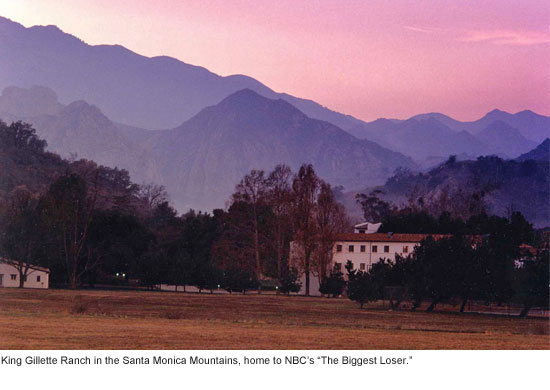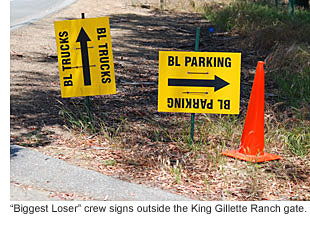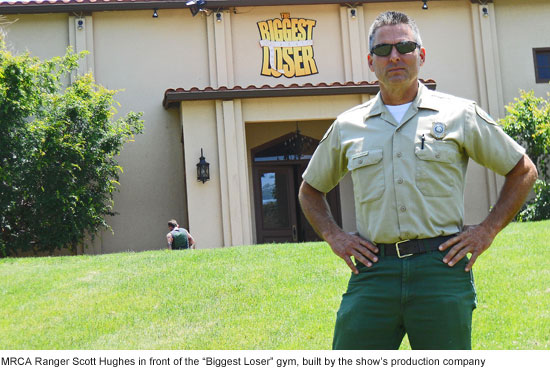Behind the scales at “The Biggest Loser”
May 24, 2011
 On the hit TV show “The Biggest Loser,” it’s known simply as “The Ranch”—a serene, sprawling property where thousands of pounds and decades of shame have been shed during the past four years.
On the hit TV show “The Biggest Loser,” it’s known simply as “The Ranch”—a serene, sprawling property where thousands of pounds and decades of shame have been shed during the past four years.
For months at a time, the mountainous acreage is home to dozens of contestants who battle their demons and their weight to gain the title of “The Biggest Loser,” along with a tidy purse of $250,000. But the property, complete with its Hollywood-imported state-of-the-art gym, is no ordinary production set.
Unbeknownst to the NBC show’s millions of fans, who’ll be tuning in for tonight’s finale, “The Ranch” is one of Los Angeles’ most historic and dazzling properties, designed by famed architect Wallace Neff in the late 1920s for razor-blade tycoon King Gillette. In 2005, an unprecedented coalition of government agencies, including Los Angeles County, raised $34 million to protect the ranch’s 600 oak-studded acres from expansive development.
Located along Mulholland Highway in Calabasas, King Gillette Ranch is being transformed into a gateway destination for the Santa Monica Mountains recreation area. A new visitor’s center currently is under construction there. The property is operated by the Mountains Recreation and Conservation Authority, which receives $50,000 a month from the show to help underwrite the agency’s operations throughout the region.
Managing the property for the MRCA is ranger Scott Hughes, a fit and trim Army veteran who has the tricky job of ensuring that the public has unfettered access to the property—including dozens of grade-school campers—while helping the show’s producers create an illusion of exclusivity and privacy. Talk about your mixed-use property.
“There’s no effective job description for this position,” Hughes says. “I add something new to it every day.” One thing, however, remains a constant above all else, he says. “It’s my job to protect this property.”
Living on the grounds with his wife and a 15-year-old son, Hughes has gotten to know not only the production crew but each of “The Biggest Loser” contestants, some of whom arrive weighing nearly 500 pounds and carrying a heavy psychological burden that has been with many of them since childhood.
“Season after season, you see them around the property,” Hughes says. “You can see the sadness in their eyes.” But then, after weeks of healthy dieting and high-intensity workouts, “you can literally see their spirits lift. It’s an amazing transition.”
There’s also been a fair share of drama on the ranch, including romances and, this season, the abrupt departure of one of the contest’s frontrunners—former Olympic wrestler Rulon Gardner, who won a gold medal in the 2000 Sydney Summer Games by beating the seemingly invincible Russian Alexander Karelin.
Gardner, 39, came to the ranch weighing 474 pounds, 200 more than during his storied wrestling career. In late April, after having lost 188 pounds, he announced during the show that he was going home “for personal reasons”—the first contestant to voluntarily walk away from the ranch, leaving behind mystery and speculation about his hasty exit.
“The Biggest Loser’s” relationship with the ranch began shortly after it was acquired as public land from the previous owner, Soka University, which had been blocked in its plan to expand the campus to accommodate some 5,000 students. The show’s crew had come to film a single competition, or “challenge,” between the contestants in season four.
But the producers quickly recognized that the property’s beauty and its structures would represent a substantial upgrade. Back then, contestants were living in the state’s old mental institution in Camarillo. Now they’d be bunking in an annex to the Gillette mansion built in the late 1950s for an order of monks by one of the ranch’s several owners over the decades, who have included MGM director Clarence Brown and church leader Elizabeth Clare Prophet.
On a recent day at the ranch, the “Biggest Loser” crew was busy preparing the place for the upcoming season, which starts production in early June. The kitchen, with its to-die-for appliances, is being redone, as are the “living room” and the bedrooms. Ranger Hughes was making sure that a dead oak limb was carefully cut by his staff so that it would not collapse on an outdoor table where interviews with contestants are sometimes filmed.
Despite all the activity, Hughes says, “this is the calm before the storm. The storm is when there’s 80 to 100 people here.”
Posted 5/24/11













 405 bridge work causes a stink
405 bridge work causes a stink
